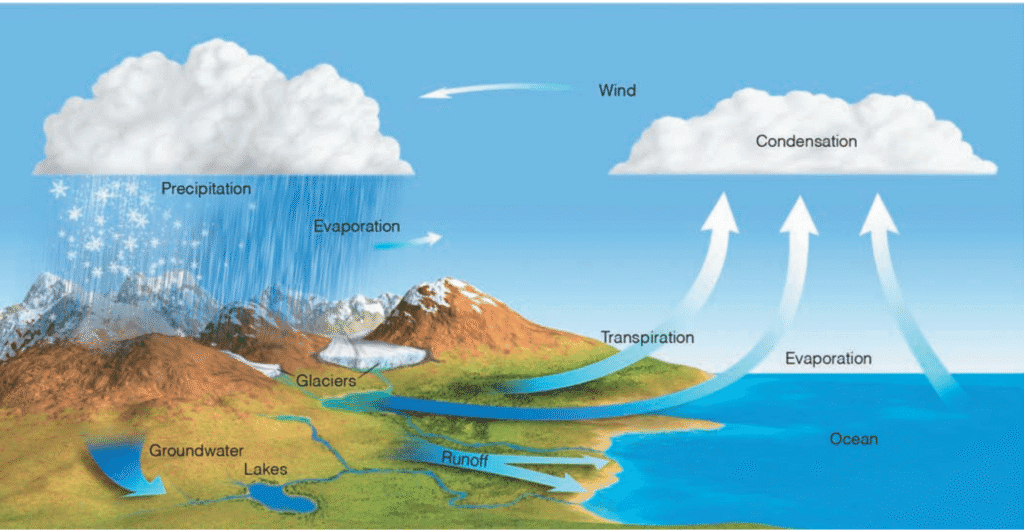Within the atmosphere, there exists a continuous and dynamic movement of water, termed the hydrologic cycle. Given that the oceans encompass more than 70 percent of Earth’s surface, this cyclical process is best conceptualized as originating above the oceanic expanse. At this point, the sun’s radiant energy facilitates the transformation of immense volumes of liquid water into vapor through the process of evaporation.
Atmospheric Transport and Phase Change
Subsequently, atmospheric winds carry this moisture-laden air toward various terrestrial regions, where the water vapor undergoes a phase change back into liquid (or occasionally solid) form, forming clouds—a transformation known as condensation. Under specific atmospheric conditions, these cloud particles, either in the form of liquid droplets or ice crystals, may increase in size and eventually descend to the surface as precipitation—manifesting as rain, snow, or hail. When this precipitation falls into an oceanic basin, the cycle recommences without disruption.
Terrestrial Water Pathways
Conversely, when the precipitation reaches continental landmasses, the return journey of water to the oceans becomes considerably more complex. This intricate cycle, where water molecules transition between liquid and vapor states and retrace their path from the oceans to the atmosphere, onto the land, and back to the sea, constitutes the fundamental process known as the hydrologic cycle.
A detailed illustration of the hydrologic cycle’s intricacies reveals that, for instance, prior to its contact with the ground, a fraction of falling rain may re-evaporate into the air. Some rainfall is intercepted by vegetation and either evaporates directly or drips to the ground well after the storm concludes. Upon reaching the surface, part of the water infiltrates the soil via percolation, filtering through small voids in the earth’s surface and rock strata, ultimately forming groundwater, which humans can access through wells. The portion that does not infiltrate the ground accumulates in surface pools or travels as runoff into streams and rivers, ultimately leading back to the ocean. Even subsurface water, though it moves at a gradual pace, eventually resurfaces and either evaporates or is transported to the ocean via fluvial systems.
Evaporation and Transpiration from Land Surfaces
Over terrestrial environments, a notable contribution of water vapor to the atmosphere arises from evaporation from soils, lakes, and rivers. In addition, plants release moisture through a process termed transpiration. In this mechanism, water taken in by a plant’s root system ascends through the stem and exits the plant through countless microscopic pores located on the underside of its leaves. Collectively, evaporation and transpiration from land surfaces contribute merely about 15 percent of the total annual atmospheric water vapor; the remaining 85 percent originates from oceanic evaporation.

Efficiency of the Hydrologic Cycle
Should the entire quantity of water vapor currently held in Earth’s atmosphere instantaneously condense and precipitate, it would suffice to blanket the globe with approximately 2.5 centimeters (1 inch) of water—a volume equivalent to just over one week’s global precipitation supply. Due to the minimal variation in this value on a daily basis, the hydrologic cycle proves to be an exceptionally efficient mechanism for the regular circulation of substantial volumes of water in and out of the atmosphere.
